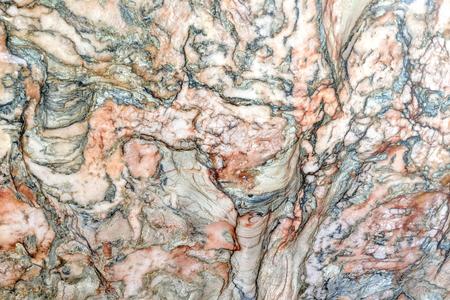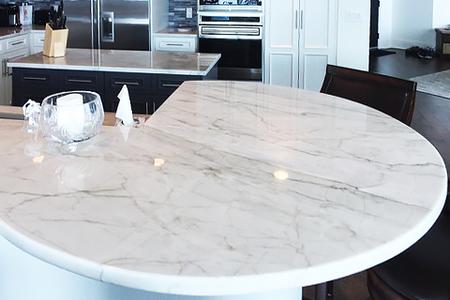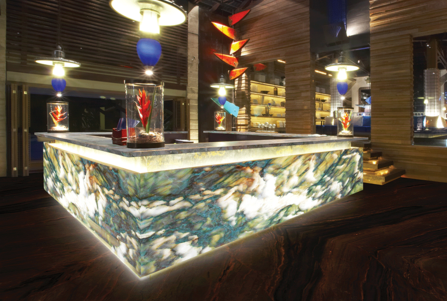Quartzite
Quartzite is a metamorphic rock made almost entirely of the mineral quartz. Quartzite begins its geologic life as sand grains, perhaps on a beach, desert dune, or riverbed. Over time, the sand grains become compressed and stuck together to form sandstone. If the sandstone gets buried ever more deeply underneath layers of rocks, it gets hotter and more compressed. With enough heat and pressure, the sand grains lose their original shape and fuse to their neighbors, forming a dense, durable rock. The process is similar to individual snowflakes merging into solid, glacial ice.
Quartzite is usually white or light-colored because quartz sand is light colored. Additional minerals carried by groundwater can impart hues of green, blue, or ion-red.
Van Gogh and Azul Macaubas quartzites are examples of vivid coloring.Regardless of color, quartzite is made of one thing: quartz. That’s helpful because quartz has distinct properties that make it easy to tell apart from other minerals. (Note I’m talking about the mineral quartz, not the composite countertop material that is also named quartz.)
Properties of quartzite
Hardness: You needn’t be a geologist to appreciate the hardness and durability of quartzite. Not only does this make for a tough stone, but it also makes it easy to tell quartzite from the imposters. Quartz is 7 on Mohs hardness scale. That means it’s harder than glass and harder than a knife blade.
Resistance to acids: Quartzite will not etch from acids like lemon juice or vinegar. Marble and dolomitic marble, on the other hand, will etch from these acids. Dolomitic marble etches slightly more slowly than regular marble. But quartzite will not etch at all from normal kitchen acids.
Porosity: Quartzite has a range of porosities. Some, like Taj Mahal or Sea Pearl, have been highly metamorphosed, and the minerals are bonded together tightly. White Macaubas and Calacatta Macaubas have been exposed to less intense pressure, so they are more porous and will benefit from sealing.
If you prefer the beauty and color of quartzite, rest assured that you are selecting a material that is strong, beautiful, and very durable. These materials may be more scratch resistant, but they are not “scratch proof.”
Quartzite is ideal for any countertop surface due to its strength and long-lasting composition. Consider quartzite countertops for its strength, beauty, and overall durability.’

Fusion Storm

Seda Perola

Alexandrita
